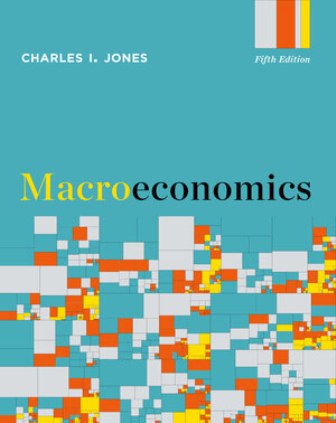This is completed downloadable of Test Bank for Macroeconomics, 5th Edition, Charles I Jones

Product Details:
- ISBN-10 : 0393417328
- ISBN-13 : 978-0393417326
- Author: Charles I. Jones
Chad Jones’s Macroeconomics teaches students to think like modern macroeconomists, with strong and engaging growth coverage and a more intuitive approach to models. Praised by adopters for its clear explanations, flexible organization, timely case studies, data, and emphasis on problem solving, Macroeconomics gives students the practical tools they need to understand and analyze the macroeconomy. This innovative text makes macroeconomics less complicated without sacrificing rigor.
Table of Content:
- Part 1: Preliminaries
- Chapter 1: Introduction to Macroeconomics
- 1.1 What Is Macroeconomics?
- 1.2 How Macroeconomics Studies Key Questions
- 1.3 An Overview of the Book
- Chapter Review
- Chapter 2: Measuring the Macroeconomy
- 2.1 Introduction
- 2.2 Measuring the State of the Economy
- 2.3 Measuring Changes over Time
- 2.4 Comparing Economic Performance across Countries
- Chapter Review
- Part 2: The Long Run
- Chapter 3: An Overview of Long-Run Economic Growth
- 3.1 Introduction
- 3.2 Growth over the Very Long Run
- 3.3 Modern Economic Growth
- 3.4 Modern Growth around the World
- 3.5 Some Useful Properties of Growth Rates
- 3.6 The Costs of Economic Growth
- 3.7 A Long-Run Roadmap
- 3.8 Additional Resources
- Chapter Review
- Chapter 4: A Model of Production
- 4.1 Introduction
- 4.2 A Model of Production
- 4.3 Analyzing the Production Model
- 4.4 Understanding TFP Differences
- 4.5 Evaluating the Production Model
- Chapter Review
- Chapter 5: The Solow Growth Model
- 5.1 Introduction
- 5.2 Setting Up the Model
- 5.3 Prices and the Real Interest Rate
- 5.4 Solving the Solow Model
- 5.5 Looking at Data through the Lens of the Solow Model
- 5.6 Understanding the Steady State
- 5.7 Economic Growth in the Solow Model
- 5.8 Some Economic Experiments
- 5.9 The Principle of Transition Dynamics
- 5.10 Strengths and Weaknesses of the Solow Model
- Chapter Review
- Chapter 6: Growth and Ideas
- 6.1 Introduction
- 6.2 The Economics of Ideas
- 6.3 The Romer Model
- 6.4 Combining Solow and Romer: Overview
- 6.5 Growth Accounting
- 6.6 Concluding Our Study of Long-Run Growth
- 6.7 A Postscript on Solow and Romer
- 6.8 Additional Resources
- Chapter Review
- 6.9 Appendix: Combining Solow and Romer (Algebraically)
- Chapter 7: The Labor Market, Wages, and Unemployment
- 7.1 Introduction
- 7.2 The U.S. Labor Market
- 7.3 Supply and Demand
- 7.4 The Bathtub Model of Unemployment
- 7.5 Labor Markets around the World
- 7.6 How Much Is Your Human Capital Worth?
- 7.7 The Rising Return to Education
- 7.8 Economic Growth and Income Inequality
- Chapter Review
- Chapter 8: Inflation
- 8.1 Introduction
- 8.2 The Quantity Theory of Money
- 8.3 Real and Nominal Interest Rates
- 8.4 Costs of Inflation
- 8.5 The Fiscal Causes of High Inflation
- 8.6 The Great Inflation of the 1970s
- Chapter Review
- Part 3: The Short Run
- Chapter 9: An Introduction to the Short Run
- 9.1 Introduction
- 9.2 The Long Run, the Short Run, and Shocks
- 9.3 The Short-Run Model
- 9.4 Okun’s Law: Output and Unemployment
- 9.5 Filling in the Details
- Chapter Review
- Chapter 10: The Great Recession: A First Look
- 10.1 Introduction
- 10.2 Recent Shocks to the Macroeconomy
- 10.3 Macroeconomic Outcomes
- 10.4 Some Fundamentals of Financial Economics
- 10.5 Going Forward
- Chapter Review
- Chapter 11: The IS Curve
- 11.1 Introduction
- 11.2 Setting Up the Economy
- 11.3 Deriving the IS Curve
- 11.4 Using the IS Curve
- 11.5 Microfoundations of the IS Curve
- 11.6 Conclusion
- Chapter Review
- Chapter 12: Monetary Policy and the Phillips Curve
- 12.1 Introduction
- 12.2 The MP Curve: Monetary Policy and Interest Rates
- 12.3 The Phillips Curve
- 12.4 Using the Short-Run Model
- 12.5 Microfoundations: Understanding Sticky Inflation
- 12.6 Microfoundations: How Central Banks Control Nominal Interest Rates
- 12.7 Inside the Federal Reserve
- 12.8 Conclusion
- Chapter Review
- Chapter 13: Stabilization Policy and the AS/AD Framework
- 13.1 Introduction
- 13.2 Monetary Policy Rules and Aggregate Demand
- 13.3 The Aggregate Supply Curve
- 13.4 The AS/AD Framework
- 13.5 Macroeconomic Events in the AS/AD Framework
- 13.6 Empirical Evidence
- 13.7 Modern Monetary Policy
- 13.8 Conclusion
- Chapter Review
- Chapter 14: The Great Recession and the Short-Run Model
- 14.1 Introduction
- 14.2 Financial Considerations in the Short-Run Model
- 14.3 Policy Responses to the Financial Crisis
- 14.4 The Aftermath of the Great Recession
- 14.5 Conclusion
- Chapter Review
- Chapter 15: DSGE Models: The Frontier of Business Cycle Research
- 15.1 Introduction
- 15.2 A Brief History of DSGE Models
- 15.3 A Stylized Approach to DSGE
- 15.4 Using the Stylized DSGE Model
- 15.5 Quantitative DSGE Models
- 15.6 Conclusion
- Chapter Review
- 15.7 Appendix: Deriving the Labor Supply Curve
- Part 4: Applications and Microfoundations
- Chapter 16: Consumption
- 16.1 Introduction
- 16.2 The Neoclassical Consumption Model
- 16.3 Lessons from the Neoclassical Model
- 16.4 Empirical Evidence on Consumption
- Chapter Review
- Chapter 17: Investment
- 17.1 Introduction
- 17.2 How Do Firms Make Investment Decisions?
- 17.3 The Stock Market and Financial Investment
- 17.4 Components of Private Investment
- Chapter Review
- Chapter 18: The Government and the Macroeconomy
- 18.1 Introduction
- 18.2 U.S. Government Spending and Revenue
- 18.3 International Evidence on Spending and Debt
- 18.4 The Government Budget Constraint
- 18.5 How Much Can the Government Borrow?
- 18.6 The Fiscal Problem of the Twenty-First Century
- 18.7 Conclusion
- Chapter Review
- Chapter 19: International Trade
- 19.1 Introduction
- 19.2 Some Basic Facts about Trade
- 19.3 A Basic Reason for Trade
- 19.4 Trade across Time
- 19.5 Trade with Production
- 19.6 Trade in Inputs
- 19.7 The Costs of Trade
- 19.8 The Trade Deficit and Foreign Debt
- 19.9 Conclusion
- Chapter Review
- Chapter 20: Exchange Rates and International Finance
- 20.1 Introduction
- 20.2 Exchange Rates in the Long Run
- 20.3 Exchange Rates in the Short Run
- 20.4 Fixed Exchange Rates
- 20.5 The Open Economy in the Short-Run Model
- 20.6 Exchange Rate Regimes
- 20.7 The Policy Trilemma
- 20.8 The Euro Crisis
- Chapter Review
- Chapter 21: Parting Thoughts
- 21.1 What We’ve Learned
- 21.2 Significant Remaining Questions
- 21.3 Conclusion
- Glossary
- Index
- Guide to Notation





